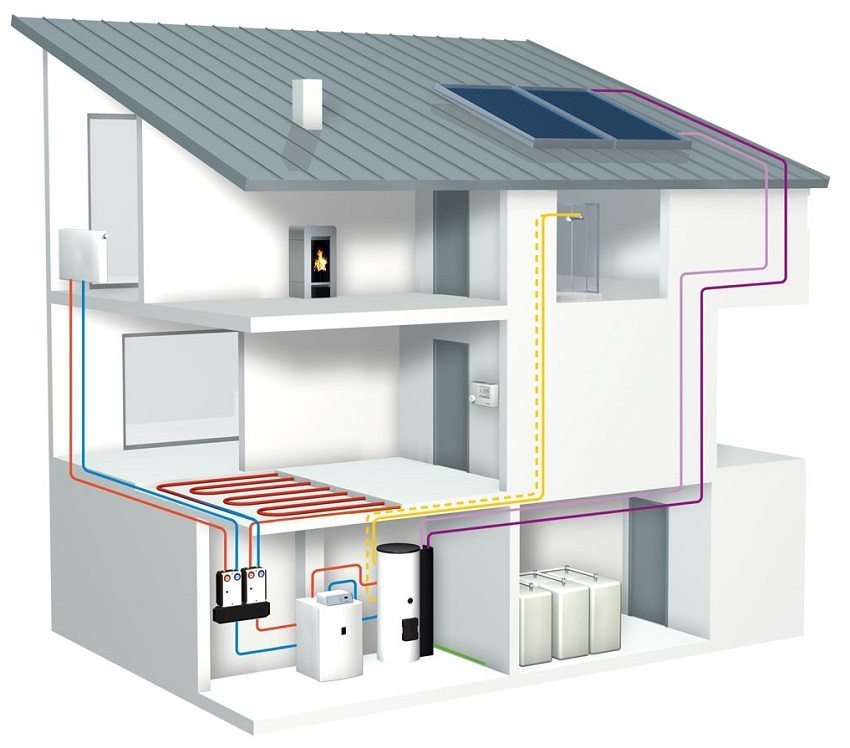This phenomenon is observed quite often, even if everything seemed to be designed and mounted correctly. The peculiarity of the appearance of condensate in the chimney is that it does not consist only of the usual droplets of water. The resulting liquid contains a lot of impurities, including resin.
 Gradually they enter into various reactions, which result in completely new chemical compounds adhering to the internal cavities of the pipes. Many of the substances( for example, acids) are harmful to the chimney.
Gradually they enter into various reactions, which result in completely new chemical compounds adhering to the internal cavities of the pipes. Many of the substances( for example, acids) are harmful to the chimney.
Pipes for the removal of combustion products are different in size, configuration, and material of manufacture - "zinced", furanflex( plastic version), brick, asbestos cement. Therefore, it is advisable to consider the most important points concerning all chimneys. The reader will understand that this information will be useful for eliminating the problems with condensate in the chimney with reference to the gas removal system installed in his house.
Consequences of condensate formation in
- pipes Destruction of the channel material. This is mainly characteristic of pipes whose internal cavity is rough( brick, asbestos-cement).
- Gradual reduction of thrust. This is quite natural, because due to the formation of "outgrowths" on the inside of the pipes, the diameter of their conditional passage decreases with time.

Causes of Condensation in the Chimney Pipe
Without knowing this, the most effective way to combat this phenomenon can not be correctly determined.
- Incorrect chimney pattern selection. This often happens when the design is carried out independently, only on the recommendations of "knowledgeable" people.
- Low temperature of combustion products( less than +100 ºС).
- Insufficient draft in the chimney.
- Significant difference in temperature values (indoors and outdoors).
- Precipitation in the channel( for example, in the absence of a hood, deflector or other protective auxiliaries).
- Use of fuel with high moisture content, incomplete combustion.
- Irregular cleaning of the chimney. As a result - excessive clogging of the channel.
- Mechanical damage to the chimney.
- Design and installation errors.
- Systematic operation of the boiler in a gentle mode( when the temperature at its output is set to insignificant).
Ways to get rid of condensation in the chimney
 Using the steam trap
Using the steam trap
This device quite effectively solves the problem. In its case( or separately) there is a special compartment for collecting condensate. The installation of a steam traps greatly simplifies the maintenance of the chimney, which practically reduces only to the timely cleaning of the drive.
The price of the device is from 786 rubles.
Thermal insulation of the chimney duct( especially at the top)
In this case, the effect of temperature changes will be minimized, as the dew point will shift.
Pre-drying of "fuel"
This applies to solid fuel boilers operating on wood, briquettes, coal and so on. First of all, it is necessary to pay attention to the order of their storage and storage conditions.

The right choice of fuel
Firewood from coniferous wood contains a large number of pitches. To use them for heating in a system with a chimney of a complex configuration or a large length is not recommended, since the risk of various deposits on the internal walls of the channel is repeatedly increased. Read more about all types of firewood here.
 Mounting the
Mounting the
mounting diagram The chimney should preferably consist of vertically oriented segments. Any slopes on the road, ledges, and so on - the cause of deposits due to condensation. The same applies to the invariance of the cross-section of the pipes along the entire length of the chimney.
Full sealing of the channel, elimination of the slightest "suction".The fulfillment of this requirement increases the draft and minimizes the formation of condensate.
Combustion temperature
Artificial increase in the temperature of the combustion products at the outlet of the chimney. This technique is not used so often, but it gives a definite result. One option is to install a special / channel( for example, an insert from a "stainless steel") or a replacement for a coaxial chimney.
Compliance with the cleaning intervals of
pipes The timely removal of soot maintains traction at the level and reduces the amount of condensate formed.


